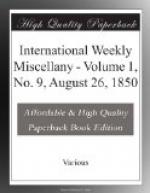“It has often occurred to us that a very interesting paper might be written on the rise and fall of English families. Truly does Dr. Borlase remark that ’the most lasting houses have only their seasons, more or less, of a certain constitutional strength. They have their spring and summer sunshine glare, their wane, decline, and death.’ Take, for example, the Plantagenets, the Staffords, and the Nevills, the three most illustrious names on the roll of England’s nobility. What race in Europe surpassed in royal position, in personal achievement, our Henries and our Edwards? and yet we find the great-great-grandson of Margaret Plantagenet, daughter and heiress of George Duke of Clarence, following the craft of a cobbler at the little town of Newport in Shropshire, in the year 1637. Beside, if we were to investigate the fortunes of many of the inheritors of the royal arms, it would soon be discovered that
‘The aspiring blood of Lancaster’
had sunk into the ground. The princely stream at the present time flows through very humble veins. Among the lineal descendants of Edmund of Woodstock, Earl of Kent, sixth son of Edward I., King of England, entitled to quarter the Royal arms, occur Mr. Joseph Smart, of Hales Owen, butcher, and Mr. George Wilmot, keeper of the turnpike-gate at Cooper’s Bank, near Dudley; and among the descendants of Thomas Plantagenet, Duke of Gloucester, fifth son of Edward III., we may mention Mr. Stephen James Penny, the late sexton at St. George’s, Hanover Square.
“The story of the Gargraves is a melancholy chapter in the romance of real life. For full two centuries, or more, scarcely a family in Yorkshire enjoyed a higher position. Its chiefs earned distinction in peace and war; one died in France, Master of the Ordnance to King Henry V.; another, a soldier, too, fell with Salisbury, at the siege of Orleans; and a third filled the Speaker’s chair of the House of Commons. What an awful contrast to this fair picture does the sequel offer. Thomas Gargrave, the Speaker’s eldest son, was hung at York, for murder; and his half-brother, Sir Richard, endured a fate only less miserable. The splendid estate he inherited he wasted by the most wanton extravagance, and at length reduced himself to abject want. ‘His excesses,’ says Mr. Hunter, in his ‘History of Doncaster,’ ’are still, at the expiration of two centuries, the subject of village tradition; and his attachment to gaming is commemorated in an old painting, long preserved in the neighboring mansion of Badsworth, in which he is represented as playing at the old game of put, the right hand against the left, for the stake of a cup of ale.
“The close of Sir Richard’s story is as lamentable as its course. An utter bankrupt in means and reputation, he is stated to have been reduced to travel with the pack-horses to London, and was at last found dead in an old hostelry! He had married Catherine, sister of Lord Danvers, and by her left three daughters. Of the descendants of his brothers few particulars can be ascertained. Not many years since, a Mr. Gargrave, believed to be one of them, filled the mean employment of parish-clerk of Kippax.




